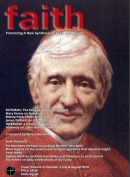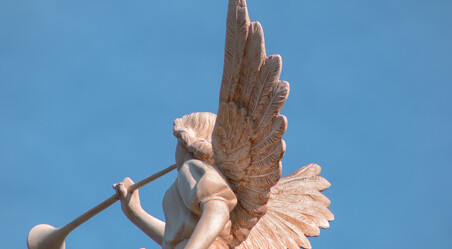Book Reviews
FAITH Magazine March-April 2004
John Cahill on an enthusiastic and thorough explanation of Confession; Robert Wilde finds God in the desert of the heart, mind and world; Suzanne Stevenson on Christ in Gethsemane as a source of consolation for those suffering from depression; James Prior on two attempts to reconcile creation and evolution which fail to convince and Christopher Jackson finds much to recommend in a guidebook for Catholics at or going to university.
Lord have Mercy. The Healing power of Confession
by Scott Hahn, DLT, 214pp £10.95
In his book ‘Lord Have Mercy – the Healing Power of Confession’, Scott Hahn offers to the reader a substantial and yet approachable explanation of the Sacrament of Penance. Broken into thirteen short chapters, of still shorter subsections, the two hundred and fourteen pages can be tackled in short sittings, which should suit even the slowest of readers as well as the busiest.
As a convert from an evangelical background Scott Hahn brings several distinctive qualities to this subject: his broad knowledge and keen love of the scriptures, the ability to communicate with a concise and often striking turn of phrase, the new found enthusiasm of a convert for perennial Catholic themes, which have sadly all too often grown stale in the hearts and minds of those who have possessed them from infancy. All of this should help to renew the reader’s appreciation of the Sacrament of Penance.
Hahn discusses all the essential elements of the Sacrament of Penance: its sacramental nature, the nature of contrition, confession and satisfaction, the role of the priest, the grace of absolution etc. But the book provides much more than just a basic catechesis. Hahn also introduces the reader to vital theological themes such as Covenant, the nature of sin and forgiveness and the meaning of Justification. He is at pains to show how Catholic doctrine and discipline accord so fully with what is to be found in the Sacred Scriptures. The book contains helpful commentaries on several relevant scriptural passages. It was this growing recognition of a coherence in all aspects of faith that lead him on the arduous intellectual road to conversion. The book also contains practical appendices withthe Rite of Penance, an examination of conscience and relevant prayers and devotions.
Hahn confronts several of the common objections to Confession. With a practical and common sense appreciation of human psychology, sometimes illustrated from his own personal experience, he demonstrates the appropriateness of the Church’s penitential discipline. In an epoch marked by a significant depreciation of Confession and the penitential dimension of the spiritual life, Scott Hahn has provided us with a coherent and attractive apologetic as an aid to its renewal.
This book has great merit on account of its theological, catechetical, apologetical and exegetical content, but above all else it is to be recommended as a spiritual manual for those who wish to renew or deepen the way in which they approach the Sacrament of Penance.
Fr John Cahill
Holy Souls
Scunthorpe
The Wilderness of God
by Andrew Louth, DLT 187pp £9.95
The stated purpose of this second edition of Andrew Louth's book, The Wilderness of God (first published in 1991) is “the different forms a spirituality of the desert has taken in Christian history”(p.1). He has chapters on Charles de Foucauld, the Scriptures, the Desert Fathers, Julian of Norwich, John of the Cross, Pere Surin, the Russian tradition, and T.S.Eliot's The Wasteland.
The author rightly says that “the image of the desert can be understood both externally and inwardly, both as an ideal that attracts as a place of spiritual experience, and as a place of desolation that is not at all sought out but rather imposed” (p.105). Since most people are not called to the physical desert or the contemplative life (although at times we should all seek solitary moments with the Lord), I will recommend Louth's book principally for crossing the “wilderness within.” For some - not all - it may well be a “place of desolation.” But we are all called to the journey inward, described in Surin's words as “this very abyss of God, drawing us more into this divine desert which is the vast solitude of God” (p.105).
Also, modern civilization itself is a kind of wilderness, a “wasteland.” Even though Louth quotes Eliot as saying that his famous poem was not a “criticism of the contemporary world... or social criticism, but only the relief of a personal and wholly insignificant grouse against life” (p.143), the fact is that the poem resonated, and continues to resonate, with countless people who experience the modern world precisely as a wilderness. Hence, the various “burning voices” of the desert tradition can help us find life as well in the wilderness of the contemporary world.
The desert dwellers presented are experienced guides through the “tangles of the mind,” as Chesterton once described the necessary modern path to Catholicism. Louth's treatment, for example, of the desert fathers' understanding of logismoi, the trains of thought that invade the heart, is especially insightful.
As they lead us along intricate desert pathways, these courageous and intrepid travellers also know how to inspire hope. Louth surprises us with the novel insight that the bible starts in a beautiful garden and ends in a resplendent city. Thus we are travelling from the garden enclosed to the heavenly Jerusalem. We are a wilderness awaiting spring blossoms, a wasteland where “the desert is becoming a city” (to use Athanasius' phrase describing the Egyptian solitaries). “If she [Julian] sees God and the soul, she sees them as a city: God has made the soul to dwell in, to live his life in, and that is the fullest, the most abundant imaginable.” (p.80)
What does each of the desert dwellers offer us moderns of the 21st century? A few examples of their wisdom. “Presence” was an important reality for Charles de Foucauld: “By his presence,” he said, “Jesus will sanctify, silently, this vast country [of the Sahara].” We too, wherever we live, can, by our love and prayer, make Jesus present, if only hiddenly, in our part of the secular city.
In the bible, the desert is seen “as a kind of trysting-place, a secret place lovers can resort to, where God can woo his beloved.”(p.34) Many of the most significant encounters of God with his chosen people occurred in the desert to purify their relationship with him, to form a people who would be his very own. We also can understand the trials of our deserts as the jealous Lover's romantic strategy to woo our hearts which were made for him alone.
If we get discouraged, the Russians give us two words to keep us "trying again": podvig (strenuous effort is necessary); and ispravlenie (trials are meant for self-improvement and correction). Keep walking! (May I mention also Catherine Doherty's word poustinia: take some time to be alone with God and his word.)
I myself was drawn to learn more about two priest spiritual directors who suffered great mental anguish but emerged to become excellent guides. Charles de Foucauld's director, “the Abbe Huvelin is even closer to our theme, in that he too can be considered a desert saint, one who dwelt in the desert, only for him it was not a literal desert but the inward wilderness of desolation of his own mind” (p.15). The other, Pere Surin, was involved in the famous Devils of Loudun affair, the subject of one of Aldous Huxley's novels. Surin's spiritual genius was “the fruit of his struggles in the desert of his madness, just as the Desert Fathers had won theirs in their ascetic struggles in the Egyptian desert” (p.106). I'd like to learn more of these two.
The book, therefore, is an excellent, short introduction to the desert tradition. It is capable of stimulating further reading which will help make your own desert bloom.
Fr Robert Wild
Madonna House
Robin Hood's Bay
Return to Gethsemane.
by John O'Brien OFM Pen Press Publishers Ltd 153pp £6.95
The bleak Garden of Gethsemane scene in Mark's gospel may appear to offer little consolation to those suffering from depression. Here Jesus is plunged into psychological darkness and waits in 'anguish and terror' as he contemplates the physical suffering he is to endure on the cross, seemingly abandoned by God. John O'Brien OFM, who has struggled with the illness for most of his life, finds in this harrowing scene, rich in themes of loneliness, compassion and prayer, the beginnings of hope and the first steps of his journey towards healing. He invites us to a new, closer reading of this passage, viewed in the context of Mark's gospel and against the reverberations of the psalms of the Old Testament, in order to reassess our relationship with God.
In the Garden of Gethsemane Jesus is utterly broken in spirit - experiencing a magnified version of modern day depression - yet still trusts and submits himself to God's will. Addressing Him as 'Abba' - indicating the unique intimacy of their relationship - even amidst his despair and recognition that his mission will end in failure and misery, he has faith that God's loving purpose will be fulfilled.
O'Brien views this as a move from loneliness to a “a solitude wherein he was sustained.” In the same way he urges us to learn to work through our suffering and gain comfort from the fact that when we do, we will also be sustained by “the One who meets us there.” Solitude he reminds us - and sometimes pain - is necessary in order to achieve a more intimate union with God.
He traces echoes of the psalms of the Old Testament in the Gethsemane scene, which focus on the suffering of the just, reaffirming their relevance to modern readers. The classic prayer of lamentation originates in the suffering of the individual but becomes a shared experience of the “afflicted” community in Israel. With its traditional cycle of alienation, fear, anger, despair and eventually reconciliation and peace, this type of psalm offers a fundamentally important and valid space in which to express the turbulent emotions of the human condition.
The indefatigable faith and love demonstrated by Jesus during his lowest ebb in Gethsemane gives us hope that we can overcome the moments of darkness in our own lives. O' Brien notes: “The great mystery revealed to us is that Jesus chose in freedom to suffer our pain. In him we grow to accept ourselves as the persons we truly are. Jesus' compassion for us who are the sick and the lonely ones makes it possible for us to face our broken selves and in our time of brokenness find a cause of hope not despair.” He finds this sense of hope again later in Mark's gospel in Jesus' anguished cry on the cross (which originates from Psalm 22) where even in the midst of his agony he encounters God. This in turn offers us comfort. According to O'Brien; “Prayer finds its extreme expression in the cry ofthe dying Christ for God - a cry in which a new relationship with God is already intimated.” Here Jesus bridges the gap between 'human desolation and divine consolation' - God is not detached from human suffering - even when He is silent - but is intimately involved in it.
The Garden of Gethsemane scene is emblematic of the intense loneliness we will all experience at some point in our own lives and the passage speaks to each one of us personally. O'Brien notes that after the disciples fall sleep, it is only the reader who shares Jesus' lonely vigil in the garden.
Analysing Mark's portrayal of Jesus' followers, he outlines what he terms their “spirituality of imperfection” showing how they failed to understand Jesus' true purpose. Their lack of understanding is highlighted by Mark through repetition, including when Jesus returns three times to Gethsemane and later Peter denies him three times. Their human failings makes us gravitate more towards Jesus, yet simultaneously make us question our own responses to him as we become more aware of our potential for failure. Do we follow the path of Jesus in all its vulnerability, pain and ever giving love or submit to our imperfections and tread the same path as the disciples? O'Brien sees this struggle at the heart of our existence as believers. He does not offer us an easy message: our challenge is tohave faith that God hears our prayer - even amidst our anguish and His apparent silence - and to work through this pain to enable us to move beyond the darkness of Gethsemane towards the new light of the resurrection.
Suzanne Stevenson
Hammersmith
London
Creation and Evolution. Rethinking the Evidence from Science and the Bible
by Alan Hayward, Bethany House Publishers distributed by St Matthew Publishing Ltd, Cambridge 232pp
Big Bang, Small Voice. Reconciling Genesis and Modern Science
by P G Nelson, Whittles Publishing, 157pp £4.50
‘Creation and Evolution’ by Alan Hayward and ‘Big Bang, Small Voice’ by P.G. Nelson both consider the scientific and biblical explanations for our existence. In their own way, the authors focus on two main areas. They discuss theories of evolution and scientific arguments for the age of the earth in contrast with the biblical narrative and the views of Christian scientists. It is worth noting here that both authors are Christians and approach the topics from that perspective, although they aim to present a fairly unbiased view. Whilst the themes of the books are homogenous, the structure and conclusion are disparate and will therefore be reviewed separately.
Dr Hayward first of all discusses Darwinism in detail. Loopholes in theories of evolution are brought to light through arguments taken from atheist or agnostic scientists. The author does this to highlight his intention of presenting a balanced viewpoint supposedly free from religious bias. He presents a convincing argument that there are large gaps in evolution theories and that the improbability of creation happening by chance is great. However, he cannot help but criticise these sources for failing to take the further step and suggest that a creator must have been responsible for our existence. Sadly, this is an underlying theme throughout the book, and detracts from the valid points the author is making.
The second part of the book deals with the issue of the age of the earth. Dr Hayward concurs with scientific research that, unless God is deceiving us, the earth is considerably older than the Bible suggests, and that this discovery presents numerous problems for the literal biblical stance on creation. The final section of ‘Creation and Evolution’ focuses on providing a solution to the impasse. Dr Hayward analyses and dismisses various potential explanations on how to reconcile the Bible to science. This includes the possibility that the biblical narrative might not indeed be a literal explanation of creation but an expression of belief. He discounts this liberal evolutionism, maintaining it was only proposed as a response to questions raised by Darwinism. But is that really a validreason to discount it? He does, however, provide his own somewhat surprising theory. He suggests that, with the use of parentheses, the Bible’s account may be made to agree with scientific discoveries into the age of the earth. He understands the six days of creation as successive 24 hour periods when God declared his creation. These declarations are described as ‘fiats’ – done deals – as that, which God declares undoubtedly will occur. Dr Hayward’s conclusion seems rather hypocritical, since, although he discredits evidence for evolution owing to gaps and assumptions, he appears then able to pull about the narrative of Genesis for his own purpose. This is indeed disappointing and detracts from his generally lucid arguments.
P.G.Nelson’s discussion of evolution versus creation comprises three main sections. The first deals with the scientific and biblical explanations in turn, discussing their relative merits. Their treatment is along the same lines as that of Dr Hayward, in analysing the detailed arguments for both sides of the divide and there is therefore no need to examine them again in this review. In contrast to Dr Hayward, however, Dr Nelson proffers a examination of the scientific stance without Christian bias, and, as such, lends more creditability to his aims. The second part then attempts to reconcile the biblical account to the scientific discoveries, and the third part scientific viewpoints to the biblical narrative. The analysis is coherent and thorough and provides a comprehensive presentationof the debate.
Dr Nelson concludes that both camps can be reconciled to each other. The reconciliation of the Bible to science seems the slightly more plausible, but, owing to the uncertainty in the whole subject and the polemic opinions that have been put forward in the past, perhaps Dr Nelson’s conclusion is the more sensible – if not rather non-committal – of the two books. To its credit, ‘Big Bang, Small Voice’ allows one to form one’s own opinion, which is perhaps all one can do with the evidence provided so far.
James Prior
Brigg
North Lincs
Catholic Student Guide. Essential reading for life at University
edited by Peter Kahn, Foreword by Archbishop Vincent Nichols, Family Publications, 110pp £4.95
How does someone applying for university decide where and what to study? Where will she live while studying? And what might determine the way in which he will live and study? These are big questions with which any student must grapple. Catholic Student Guide - essential reading for life at university, enables the student to consider such questions from a Catholic point of view. The Guide makes no bones about, or apologies for considering these questions from within the matrix of Church teaching. Inevitably, students will want both to discuss and to disagree with some of the views expressed in the Guide; that is as it should be. Here then, is a starting point for their discussion.
The Guide, published by Family Publications, is edited by two people currently working in the university milieu, Peter Kahn, an educational developer at Manchester, and Jeremy Fairhead, Catholic chaplain at Oxford. There are two parts: first, a series of articles by students and graduates, interspersed with shorter contributions arising out of students' personal experience; second, details of the chaplaincies in England and Wales on a regional basis and other listings. Each region's chaplaincy details also includes organisations providing opportunities for Catholic students. On a national basis there are details of Catholic further education, other organisations likely to be of interest to Catholic students, and information on gap years. The Guide ends by listing internet resources,including some particularly valuable ones on prayer.
Here then, is a mine of information, and it would be easy to assume that this guide is specifically for students already at university. Certainly some of it is for them, but several of the articles contain advice about how to choose a course, a university, accommodation and so on. Clearly, the Guide also needs to be put into the hands of those who are just beginning to consider what the future might hold for them. Perhaps parishes might invest in some to distribute to young people who are considering further education? Certainly, there ought to be a copy for reference in every school and sixth form college. New editions of the Guide will normally appear bi-annually, so there is every hope that the listings will not be out of date.
Part one of the Guide, entitled “Essential Reading” is something of a curate's egg - excellent in parts. There are clear, honest and direct articles like the one on student lifestyle. In this contribution by Julie and Cyrus Olsen there is no ducking of the issues which will confront every student at some time in their university career. The truth as taught and believed by Catholics is set out clearly and realistically, backed up by a contribution from a student who underwent the trauma of abortion. “Growing in faith” provides a useful, practical introduction about how to begin to pray, based on Pope John Paul II's recommendations to young people. Students reading theology might take issue with the somewhat simplistic approach towards scripture which this article recommends, but it is hardto see how this could have been avoided in something which is no more than a 'taster' of the riches of Christian ways of prayer. Throughout the Guide there are references to traditional forms of devotion which have been rediscovered by young people in recent years as well as to the Sacrament of Reconciliation. A contribution from James Leatherland, a recent graduate of Luton University, sounds a very optimistic note: on finding that there was nothing organised for students in the parish where he lived, he set about networking with other young Catholics and a group committed to prayer, socialising, and education evolved. Evidently, students do not have to be spoon-fed; they may do far better if they are encouraged to set up their own structures. A sign of hope, as well as a somewhatsobering thought, to university chaplains.
The pictures of students in the book are all in black and white - unfortunate, since the impression is given that the vast majority of them belong to only one ethnic grouping. This may mean that the Guide does not easily recommend itself to a multi-ethnic student population.
All in all, however, the Guide is a brave attempt and deserves to succeed. No doubt future editions will be able to build on the foundations laid by this first attempt as well as learning from the criticisms which it will attract.
Christopher Jackson,
Catholic chaplain
Sunderland University






